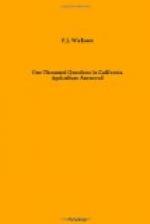Bean Growing.
We have a small field of beans, and would like to know which is the best and most profitable way to crop them.
Cultivate the beans so that the plants may have plenty of moisture to fill the pods, then let them dry and die. Gather the dry plants before the pods open much, and let them dry on a clean, smooth piece of ground or on the barn floor. When they are well dried, thresh with a flail, rake off the straw, sweep up the beans and clean by winnowing in the wind or with a fanning mill with suitable screens.
Hoeing Beans.
Should beans be hoed while the dew is on the vine?
Beans had better be hoed with the dew on them than not hoed at all. The only objection to hoeing with the dew on is that the hoer will get his feet wet, the vines will become untidy from adhering dust, with a possible chance of the leaves becoming less effective and the pollination of the blossom rendered less liable to occur.
Beans as Nitrogen Gatherers.
I grow string beans in my rotation to restore nitrogen, but I see it stated that not all beans are valuable for this purpose. Are the common bush varieties nitrogen gatherers?
Probably they are all doing it in various degrees. Pull up or dig up a few plants when growing actively, not too early nor too late in the season, and look for nodules on the roots. Number and size considered together will measure their activity in this line in your soil.
Bean Growing.
I want to plant beans of different varieties. The land is rich, black loam with a little sand. When is the best time to plant? If planted early, what shall we do to keep the weevils out of them?
It is desirable to plant beans as early as you can without encountering danger of frost killing. No particular date can be mentioned for planting because the dates will vary in different locations according to the beginning of the frost-free period. The best way to escape weevil is to sell most of the beans as soon as harvested, treating those which you retain for seed, or for your own use, with bisulphide of carbon vapor or by gently heating to a temperature not above 130 degrees, which, of course, must be done carefully with an accurate thermometer so as not to injure germinating power. Unless you know that beans do well in your locality, it would be wise to plant a small area at first, because beans are somewhat particular in their choice of location in California, and one should have practical demonstration of bearing before risking much upon the crop.
The Yard-Long Bean.
I wish to ask about the very long bean which I think was introduced from China into California. I remember seeing one vine when I was living in California which I think must have been 20 or 30 feet long and had hundreds of pods and each of these pods were from 2 to 3 feet long. Are these beans generally considered eatable? Would they be at all suitable to get as a field bean which the hogs eat?




